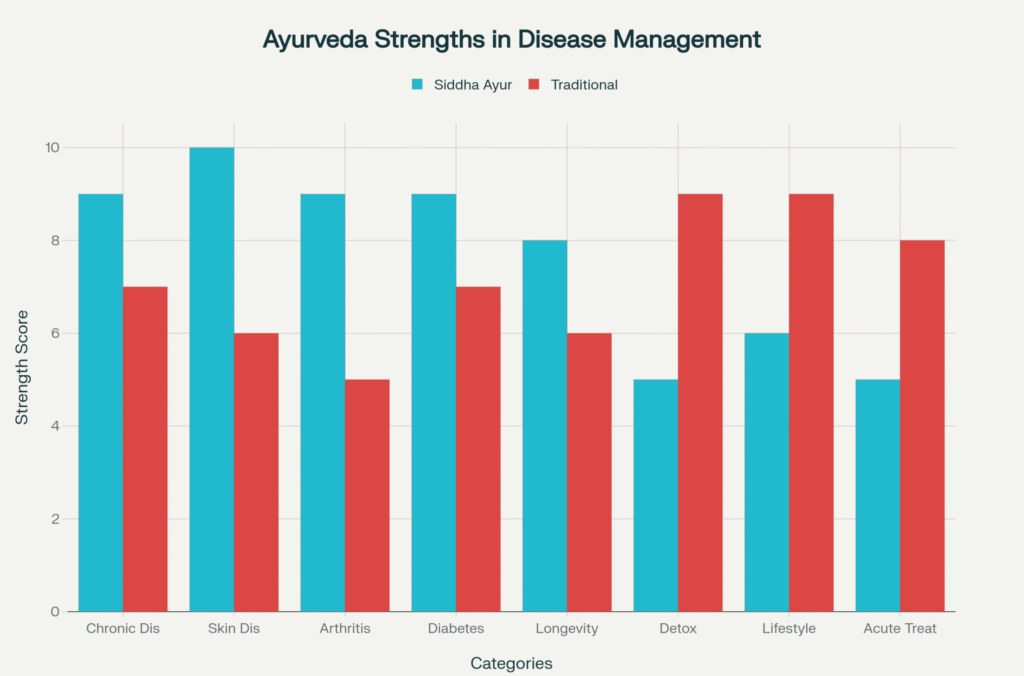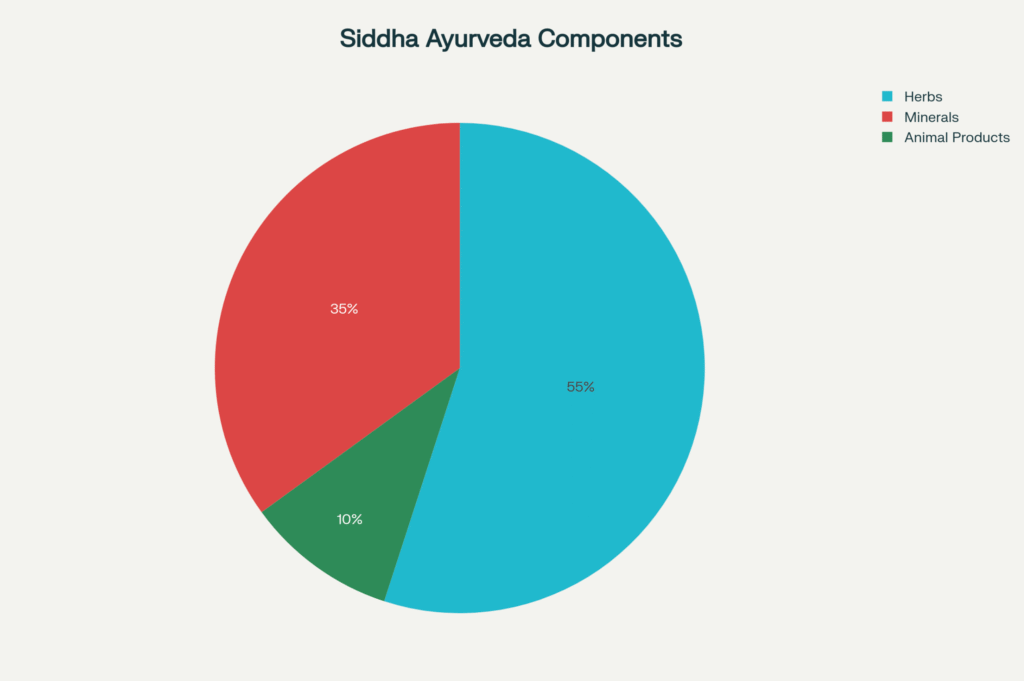Siddha Ayurveda has always intrigued me as one of India’s most ancient and enigmatic healing systems. My journey to understand Siddha Ayurveda—its origins, how it differs from traditional Ayurveda, and whether one system can be considered superior—has led me deep into the core of India’s traditional medicine heritage. In this long, reflective article, I’ll share my perspective on what makes Siddha Ayurveda unique, and how both approaches address disease and health in the Indian context.
Discovering Siddha Ayurveda’s Origins
Siddha Ayurveda, widely recognized as Siddha medicine, is believed to have originated in South India, especially Tamil Nadu, with roots tracing back to the Dravidian civilization and possibly to 10,000 BCE according to some Sangam-era sources. Its foundational philosophy arises not only from medical texts but also from a rich tradition of spiritual practice established by the Siddhars—enlightened sages regarded as both healers and spiritual masters. Siddha Ayurveda’s teachings emphasize that the human body is a microcosm of the universe, integrating five basic elements: earth, water, fire, air, and space. Practitioners aim for “mukthi” (liberation) and perfection of mind, body, and spirit through health.
The mythology states that Lord Shiva taught the principles of Siddha Ayurveda to his consort Parvati, who passed it to Nandhi, and then to 18 Siddhars. The legacy was then documented in classical Tamil literature and passed down through generations.
Key Differences: Siddha Ayurveda vs. Traditional Ayurveda
Both Siddha Ayurveda and traditional Ayurveda use holistic approaches but differ in foundational philosophies, materia medica, and regional application. Here is a comparative perspective:
| Aspect | Traditional Ayurveda | Siddha Ayurveda |
|---|---|---|
| Geographic Origin | North India, Vedic culture | South India, Tamil tradition |
| Language of Texts | Sanskrit | Tamil |
| Founders | Charaka, Sushruta | Siddhars, Agastya |
| Philosophy | Three doshas (Vata, Pitta, Kapha) | Three humours (Vatham, Pitham, Kapham) |
| Materia Medica | Mainly herbal, some metals | Herbs, minerals, metals, animal products |
| Treatment Approach | Panchakarma, herbal oils, dietary rules | Parpam (calcined minerals), thailam (oils), yoga, dietary and lifestyle protocol (pathiyam) |
| Primary Focus | Disease management, lifestyle | Chronic diseases, rejuvenation, anti-aging (Kayakalpa) |
| Diagnosis | Pulse, tongue, eye, urine | Eight-fold diagnostic system including urine, pulse, perception and speech |
| Strength | Detoxification, lifestyle, acute disease | Skin disorders, chronic conditions, arthritis, diabetes, longevity therapies |
Siddha Ayurveda is deeply integrated with Tamil culture and uses mineral and metal-based medicines more extensively than traditional Ayurveda, which remains more herbal. Siddha places profound importance on spiritual health and rejuvenation, often describing Kayakalpa therapies for anti-aging and longevity.
Is Siddha Ayurveda Better Than Traditional Ayurveda?
Having interacted with both systems, I can say that “better” is subjective. Siddha Ayurveda has unique strengths in chronic disease management—especially skin conditions, arthritis, diabetes, and even some refractory diseases. Its mineral-rich and metal-based treatments are highly prized by practitioners in southern India and those seeking alternatives for conditions poorly managed by conventional medicine.
Traditional Ayurveda, meanwhile, is widely practiced, researched, and standardized across India, making it more accessible for common health issues, preventive care, and detox therapies like Panchakarma. Ayurveda’s approach to balancing doshas, stress reduction, and digestive wellbeing has universal appeal.
Ultimately, the decision comes down to the condition being treated, personal preference, and cultural context. Siddha Ayurveda excels with chronic and degenerative conditions, while traditional Ayurveda is often the first choice for daily wellness, acute illnesses, and lifestyle correction.
Approaches in the Indian Context
In India, Siddha Ayurveda forms a vital part of the healthcare landscape, especially in Tamil Nadu, where Siddha hospitals and practitioners offer specialized treatments for chronic, complex, and skin-related diseases. Siddha medicine is supported at the national level through institutes like the National Institute of Siddha in Chennai, focusing on education, research, and clinical care.
Traditional Ayurveda remains the backbone of Indian holistic medicine, with institutions, clinics, and research centers in every state. Both Siddha Ayurveda and Ayurveda are recognized and regulated under the Ministry of AYUSH, integrated into government healthcare efforts for both preventive and curative medicine.
Disease Focus: What Does Siddha Ayurveda Treat?
Siddha Ayurveda’s most celebrated specialty is chronic disease management:

- Skin diseases (eczema, psoriasis, leprosy): Renowned for its multi-drug protocols and herbo-mineral remedies.
- Arthritis and orthopedic conditions: Mineral-based parpam, external therapies, and oils are used for joint pain and stiffness.
- Diabetes and urinary conditions (“Meka Noikal”): Recognizes diabetes and venereal diseases as caused by urinary pathology and offers dietary and pharmacological solutions.
- Geriatric, anti-aging, and rejuvenation (Kayakalpa): Combines lifestyle changes, medicine, and yoga for longevity.
- Respiratory, cardiovascular, psychiatric diseases: Treatments increasingly documented through clinical research.

Traditional Ayurveda is strong in:
- Metabolic and digestive disorders
- Mental health and stress management
- Reproductive health
- Detoxification (Panchakarma)
- Lifestyle disorders like obesity and hypertension
How Treatment Works
In Siddha Ayurveda, treatment is highly individualized. Diagnosis includes eight-fold assessments: pulse, tongue, urine, complexion, speech, and palpation. Siddha emphasizes “pathiyam”—lifestyle and dietary protocols—alongside medicines made from herbs, minerals, and metals. Skin and chronic ailments receive multi-pronged therapy, from internal formulations to external applications and yoga.
Ayurveda diagnosis is based on dosha assessment, tongue and pulse reading, and customizing remedies to restore balance. Both systems strongly stress prevention and holistic wellness.
Herbs, Minerals, and Animal Products
| Category | Siddha Ayurveda | Traditional Ayurveda |
|---|---|---|
| Herbs | Solanum trilobatum (Thuthuvalai), Evolvulus alsinoides (Vishnukiranthi), Cardiospermum halicacabum (Mudakathan), Indigofera aspalathoides (Sevvaan), Cissus quadrangularis (Pirandai), Mukia maderaspatana (Musumusukkai), Tinospora sinensis (Sentil), Andrographis paniculata (Nilavembu), Oldenlandia umbellata (Kariyilai), Centella asiatica (Vallarai), Ocimum tenuiflorum (Tulsi) | Ashwagandha (Withania somnifera), Brahmi (Bacopa monnieri), Triphala (Amalaki, Bibhitaki, Haritaki), Guduchi (Tinospora cordifolia), Turmeric, Neem, Shatavari, Boswellia, Guggulu, Bitter melon, Licorice root, Amla |
| Minerals | Mercury, Sulphur, Gold, Silver, Iron, Copper, Lead, Zinc, Arsenic, Coral, Conch, Calcined minerals (Parpam, Chendooram) | Sulphur, Arsenic, Lead, Mercury, Gold, Copper Sulphate, Mica, Bhasmas (calcined minerals and metals used in treatments) |
| Animal Products | Horn of deer, musk, honey, cowrie shell, coral, conch | Milk, ghee, honey, musk, pearl, shells |
Siddha Ayurveda is renowned for its sophisticated herbo-mineral combinations and innovative dosage forms like Parpam (calx), Chendooram (calcined red oxide), and Lehiyam (herbal jam). Ayurveda, while also using mineral derivatives in bhasma preparations, remains predominantly herbal.
Clinical Evidence, Trials, and Regulatory Status
Both systems are regulated under India’s Ministry of AYUSH. The Drugs and Cosmetics Act, 1940 and subsequent amendments provide a robust framework for the manufacturing, quality control, and regulation of Ayurveda and Siddha medicines. Licensing, mandatory safety studies, and GMP certifications are enforced through state authorities and Drug Testing Laboratories. Siddha Ayurveda medicines are prepared under rigorous state licensing, and official pharmacopoeias guide their standards.
Clinical research in Siddha Ayurveda is actively promoted by the Central Council for Research in Siddha (CCRS) and through collaborations with the National Institute of Siddha (NIS), Chennai. Numerous studies and trials have validated Siddha’s efficacy in managing chronic diseases such as skin disorders, diabetes, osteoarthritis, and certain cancers. For example:
- Cancer management: Siddha medicines with mercury, sulphur, garlic, ginger, and long pepper have been shown to provide symptomatic relief and support conventional therapies.
- Diabetes and metabolic disorders: Clinical trials and population studies have supported the use of Siddha polyherbal preparations.
- Research in Ayurveda is more widely published, with clinical trials supporting herbs like Ashwagandha, Brahmi, and Triphala for stress, cognitive enhancement, and digestive health.
Panchakarma-like and Unique Therapies in Siddha Ayurveda
Siddha Ayurveda recognizes a variety of internal and external therapies—some analogous to Panchakarma in traditional Ayurveda:
- Therapeutic Purgation (Virechanam): Cleanses excess Vatham (air element).
- Therapeutic Emesis (Vamanam): Used to balance Pitham (fire element).
- Therapeutic Nasal Instillation (Nasiyam): Regulates Kapham (earth/water elements).
- Raktamokshana (Bloodletting): Employed for certain chronic and skin conditions.
- Varmam Therapy: Distinctive to Siddha, this pressure-point therapy manipulates vital energy centers, aiding in pain management and injury recovery.
- Tokkanam (Physical Manipulation): Encompasses massage, manipulation, and bone setting.
- Kizhi and Elakizhi: Herbal poultices or heated bundles applied to joints and muscles, similar to herbal fomentation in Ayurveda.
- Pizhichil (Oil Bath): Warm medicated oil poured and massaged for joint pain and rejuvenation.
- Kayakalpa Therapy: Siddha’s unique anti-aging and rejuvenation program using select herbs, minerals, lifestyle modifications, and yoga.
Both systems prioritize dietary regulation, tailored lifestyle advice, seasonal routines, and ethical living for holistic well-being.
Final Reflections
Siddha Ayurveda offers profound healing possibilities, especially for those seeking alternatives to standard treatments or who have chronic illnesses unresponsive to conventional medicine. Its unique connection to Tamil tradition, spiritual health, and mineral-based therapeutics makes it a treasure of Indian medical heritage.
Meanwhile, traditional Ayurveda remains my preferred choice for everyday wellness, stress management, and preventive care. Both systems, with their holistic, individualized approaches, continue to inspire my respect for India’s medicinal heritage.
In this journey, Siddha Ayurveda and traditional Ayurveda are not rivals but complementary traditions—each empowered to help us find balance, health, and spiritual well-being in a complex world.
Note: The article includes detailed tables illustrating differences and materia medica, plus insights into the clinical and therapeutic aspects of Siddha Ayurveda alongside traditional Ayurveda.





0 Comments